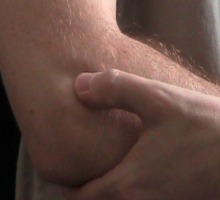
The Tennis Elbow "symptom spot"
The symptoms of Tennis Elbow can include pain, weakness and tenderness at the outer elbow area (your Lateral Epicondyle). What IS Tennis Elbow?
If the same thing is happening at your inner elbow, you may have Golfers Elbow instead of or in addition to your Tennis Elbow. How Tennis Elbow is diagnosed
Most of the time the elbow pain starts gradually – Although if yours flared up in searing pain one day, seemingly without warning that’s not unheard of.
Sudden onset happens pretty often in racquet sports, golf and other high-impact sports and physical occupations like construction.
The pain usually creeps up on you and slowly builds, along with periods of forearm muscle fatigue or soreness that go away after a day or so – but which tend to take longer to resolve with each recurrence.
The Muscle Resistance Test For Tennis Elbow
The most common test is to try to extend your wrist against resistance (take the wrist backward, as in the opposite of gripping) and if this is painful, particularly right at the outer elbow, it’s considered a positive sign of Tennis Elbow (especially if you’ve been having symptoms for several weeks, whether on and off or more or less continuously)
And recurrences are the rule rather than the exception. In my opinion largely because the usual medical treatments do a lot more harm than good and are contradictory to your body’s natural healing process.
(Had to slip that in there – even though we’re just outlining symptoms here.)
Symptoms in the tendons at your outer elbow
In the tendons attached to your outer elbow which define Tennis Elbow you may feel or notice:
- Pain: Sharp, dull or burning – from a mere whisper to a scream,
- Stiffness: It can become difficult to bend your elbow,
- Tenderness: The outer elbow area often feels tender to even a light touch,
- Swelling: It’s possible for fluid to build up around your elbow because of inflammation, but swelling that you can actually see (puffiness) is very rare with Tennis Elbow
Pain is by far the most obvious symptom. It can be anything from a mild ache, to an intense sharp or general burning sensation.
Let me tell you one thing right now though: The type or intensity of the pain tells you almost nothing about what’s really going on in those tendons or how bad it is.
Yes. I know that makes no sense, but there isn’t necessarily any correlation between the level or kind of pain and the seriousness of the problem. Tendon problems are notoriously tricky!
In the ebook I explain why you can have a lot of pain and not have a serious condition and on the other hand you can be in a lot of trouble and actually be in very little pain. It cuts both ways.
(More about the ebook at the end of the article below.)
Stiffness – especially first thing in the morning is very common
Heat can be very helpful with that stiffness if you experience it in the morning – or any time – and in general most of the time (unless there’s significant, visible swelling or the injury is recent within the last three days or so.)
On no! I’ve violated one of the sacred cows of Tennis Elbow!… Recommending heat instead of ice.
What about the inflammation?
Forget about it. It’s actually part of the healing process. Watch my video ‘Tossing The Tendonitis Myth’ for more on that.
Symptoms in the muscles of your forearm
Along with the pain and other symptoms in the tendons at your elbow, you may feel some things in the muscles they’re connected to.
These are the muscles in your outer forearm that extend your wrist and fingers primarily:
- Soreness: It’s very common to have soreness or tenderness to the touch in these muscles,
- Fatigue: These muscles are very often overworked, tense and tired – and they often FEEL it!,
- Weakness: Not everyone with Tennis Elbow feels weak in theses muscles – but a feeling of weakness, often with sharp pain in the tendons at the elbow with certain wrist and elbow movements is fairly common
Do you feel apprehension about shaking hands, picking things up and especially doing anything with a twisting motion, like opening jars?
If some or all of those motions cause you pain that’s quite common. I’ve seen cases where a tiny motion like simply buttoning a button or turning a doorknob causes sharp pain.
This can be because of damage to your tendons – You shouldn’t automatically jump to that conclusion, however.
As I explain in the ebook, you can be in a lot of pain because of muscle weakness and/or tension without necessarily having reached the injury stage where your tendons are actually being DAMAGED.
Here’s a muscle-related article that goes into a little more detail on that:
How Muscle Weakness Causes Tennis Elbow
Symptoms “spreading” to other areas
As tight, overworked muscles become weaker and the pain worsens – and you alter how you move to try to avoid the pain -you may begin to feel as if the symptoms are spreading, say into your neck and shoulder.
This is usually just the symptoms of “complaining” muscles that are compensating for your weakened wrist/forearm muscles and the unintended consequence of long-term pain-avoidance habits.
The sense of this symptom creep can be quite alarming, though – and these symptoms can become severe themselves.
So much so that it leads to a lot of pointless MRIs and X-rays, looking for non-existent (usually) spinal abnormalities affecting the nerves to the arm.





Leave a Reply